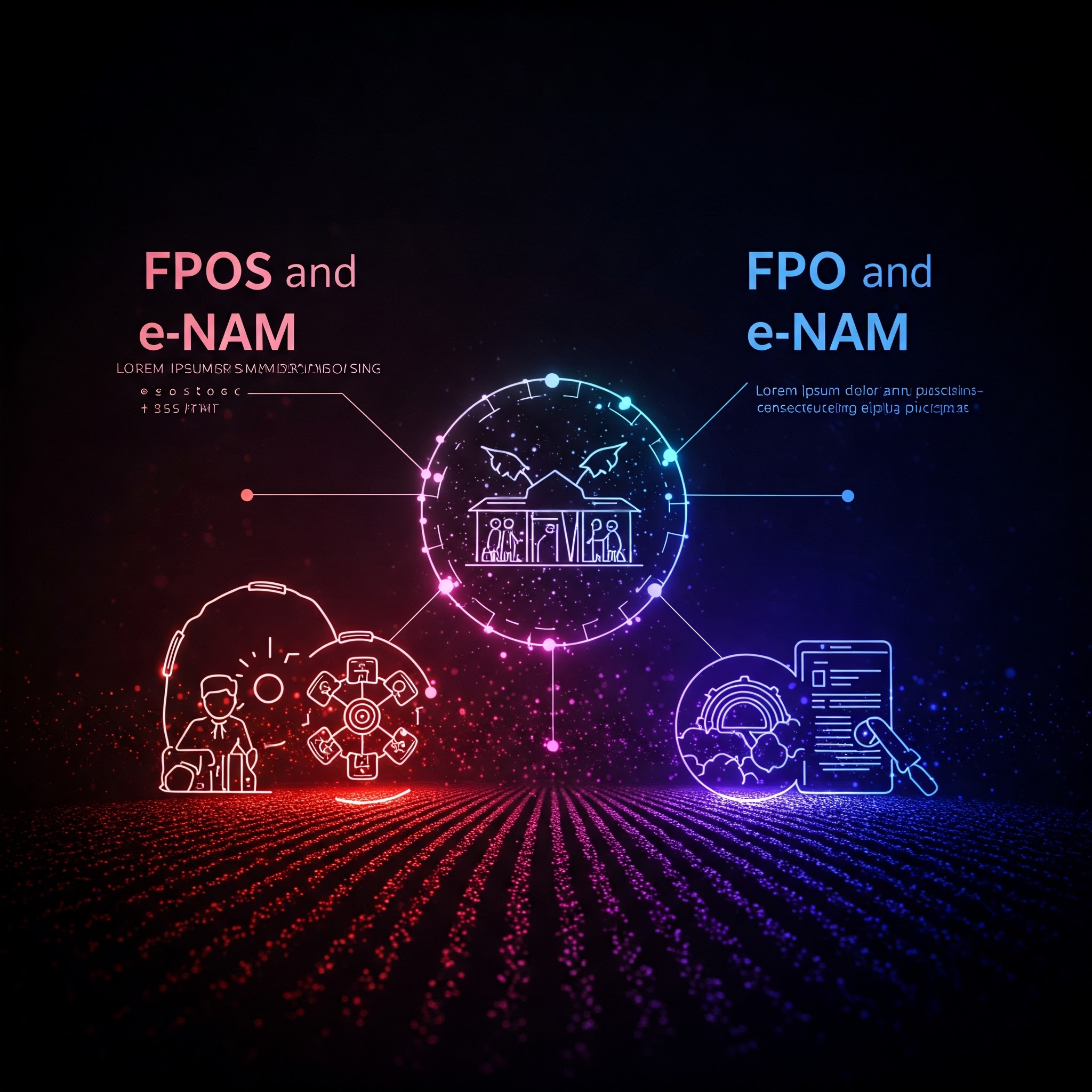Introduction
Indian agriculture, despite being a major livelihood source for more than 50% of the population, has long been trapped in issues of fragmentation, low productivity, price volatility, and weak market linkages. In this context, two key institutional reforms—Farmer Producer Organizations (FPOs) and the electronic National Agriculture Market (e-NAM)—have been introduced to transform the structure of agricultural marketing and empower farmers.
While FPOs aim to collectivize small and marginal farmers to increase their bargaining power and market access, e-NAM seeks to create a unified national digital platform for transparent price discovery and efficient trading. Together, they represent an effort to shift Indian agriculture from a supply-side focus to a market-driven ecosystem.
This article critically evaluates the potential and performance of FPOs and e-NAM in transforming Indian agriculture, their achievements, challenges, and the way forward.
Understanding Farmer Producer Organizations (FPOs)
Definition and Objectives
A Farmer Producer Organization (FPO) is a collective of farmers registered as a legal entity—usually a Producer Company under the Companies Act. It is formed to enable farmers to leverage collective strength, access inputs at lower costs, engage in direct market linkage, and increase incomes.
Key Objectives:
- Enhance farmers’ bargaining power.
- Reduce input costs through bulk procurement.
- Promote value addition, storage, and processing.
- Facilitate access to credit, insurance, and extension services.
- Create economies of scale in marketing and post-harvest management.
Government Support for FPOs
- 10000 FPO Scheme (2020): Launched by the Government of India to form and promote 10,000 new FPOs by 2027-28 with a budget of ₹6,865 crore.
- NABARD, SFAC (Small Farmers’ Agribusiness Consortium), and National Rural Livelihood Mission (NRLM) act as implementing agencies.
- Financial and technical assistance including equity grant, credit guarantee, and capacity building is provided.
Impact of FPOs on Indian Agriculture
1. Empowering Small and Marginal Farmers
India has over 86% small and marginal farmers, often unable to negotiate fair prices or access quality inputs. FPOs help these farmers by:
- Aggregating produce for bulk sale.
- Reducing dependence on middlemen.
- Providing a collective identity in the market.
Case Example: The Dharmapuri Organic Farmers’ Producer Company in Tamil Nadu enabled tribal farmers to market their millets and organic produce directly to retailers and e-commerce platforms.
2. Improving Access to Inputs and Technology
FPOs have facilitated:
- Bulk purchase of fertilizers, seeds, and machinery at subsidized prices.
- Adoption of modern technologies through shared knowledge and extension services.
- Reduction in input costs and improvement in yields.
3. Promoting Agro-Processing and Value Addition
Some FPOs are now setting up primary processing units, cold storages, grading, and packaging centers. This has:
- Enhanced the value of produce.
- Enabled FPOs to sell directly to supermarkets and exporters.
4. Better Access to Finance and Insurance
FPOs are recognized entities eligible for:
- Collateral-free loans from banks.
- Insurance products tailored for groups.
- Financial literacy and credit linkage services.
5. Women Empowerment and Social Inclusion
Several FPOs actively involve women SHGs (Self Help Groups), leading to:
- Increased rural women participation in agribusiness.
- Improvement in household income and decision-making roles.
Challenges Faced by FPOs
Despite their promise, FPOs face several hurdles:
1. Lack of Professional Management
- Many FPOs lack trained personnel in finance, marketing, and operations.
- Dependency on government support affects sustainability.
2. Limited Working Capital
- Access to startup capital remains a major issue.
- Credit flows are often delayed or insufficient.
3. Weak Market Linkages
- Many FPOs are unable to find reliable buyers.
- Absence of robust branding and packaging affects competitiveness.
4. Regulatory and Compliance Burdens
- FPOs face complex legal and tax compliance requirements.
- Difficulty in managing statutory obligations under the Companies Act.
5. Fragmentation and Duplication
- Poor coordination among implementing agencies leads to duplication of efforts.
- Some FPOs remain inactive or dormant due to poor leadership or viability issues.
Understanding e-NAM (Electronic National Agriculture Market)
What is e-NAM?
Launched in April 2016, the electronic National Agriculture Market (e-NAM) is a pan-India online trading platform designed to integrate physical APMC mandis across states to facilitate:
- Transparent and competitive price discovery.
- Real-time online trading of agricultural commodities.
- Access to buyers and sellers beyond the local mandi.
Objectives of e-NAM:
- Create a unified national market for agricultural commodities.
- Eliminate intermediaries and reduce transaction costs.
- Ensure better price realization for farmers.
Key Features:
- Inter-mandi and inter-state trade.
- Online payment and transaction history.
- Weighing, assaying, and grading services at mandis.
- Mobile app for farmers and traders.
Impact of e-NAM on Agricultural Marketing
1. Transparent Price Discovery
- Real-time auctions help farmers understand market trends.
- Competitive bidding ensures better prices than traditional auctions.
2. Market Expansion
- Farmers can access buyers from other states, expanding market reach.
- Inter-state trade allows crops to move from surplus to deficit regions.
3. Reduction in Malpractices
- e-NAM reduces collusion and cartelization in mandis.
- Digital payments help avoid arbitrary deductions and delays.
4. Digitization and Traceability
- Record-keeping, grading, and standardization bring transparency.
- Beneficial for traceability, export compliance, and consumer trust.
5. Integration with FPOs
FPOs act as sellers on e-NAM, helping their members gain:
- Collective price negotiation.
- Bulk selling on transparent platforms.
Challenges and Limitations of e-NAM
1. Limited Mandi Integration
- As of 2023, only around 1300+ APMCs are integrated out of over 7000 mandis.
- Many states are yet to implement full-scale digitization.
2. Infrastructure Deficit
- Mandis lack grading labs, weighbridges, internet connectivity, and storage.
- Poor logistics discourage participation in online trading.
3. Farmer Awareness and Training
- Many farmers, especially elderly and illiterate ones, are unaware or reluctant.
- Digital illiteracy and language barriers persist.
4. Dominance of Local Traders
- Local traders resist online auctions to protect their monopoly.
- Lack of institutional buyers reduces competitive bidding.
5. Lack of Legal Clarity
- In some states, mandi laws hinder seamless interstate trade.
- Multiple licensing and fee structures act as barriers to integration.
FPOs and e-NAM: Complementary Role in Agricultural Transformation
1. Market Linkage through Technology
- FPOs can act as aggregators and sellers on e-NAM, ensuring their members access better prices.
- e-NAM provides the platform, while FPOs provide the volume and quality.
2. Improving Bargaining Power
- e-NAM allows price comparison and real-time bids, while FPOs negotiate bulk deals.
- Reduces dependence on exploitative local traders.
3. Enhancing Farmer Income
Both reforms help in:
- Reducing transaction costs.
- Eliminating middlemen commissions.
- Improving net returns to farmers.
4. Enabling Digital Agriculture
These institutions promote a shift from traditional to modern agriculture through:
- Data-driven decision-making.
- Online transactions and transparency.
- Climate-smart and market-smart farming approaches.
Policy Recommendations and the Way Forward
1. Strengthen Capacity Building
- Provide professional training to FPO board members in finance, governance, and marketing.
- Increase digital literacy among farmers for e-NAM participation.
2. Simplify Regulatory Environment
- Ease compliance norms for small FPOs.
- Harmonize mandi laws and taxation across states for smooth e-NAM operations.
3. Invest in Infrastructure
- Improve grading labs, storage, and logistics in APMCs.
- Ensure broadband and digital infrastructure in rural mandis.
4. Promote Aggregator Models
- Encourage FPOs to function as service providers, linking members to e-NAM, markets, and agri-tech solutions.
5. Foster Public-Private Partnerships
- Collaborate with agribusinesses, NGOs, and digital startups to mentor FPOs and scale up e-NAM adoption.
6. Monitor and Evaluate Outcomes
- Create an independent mechanism to evaluate the economic impact of FPOs and e-NAM on farmers’ incomes and livelihoods.
Conclusion
FPOs and e-NAM represent transformative interventions in Indian agriculture, targeting the core issues of market access, price realization, and farmer empowerment. While they have shown significant promise in pockets, large-scale success requires sustained policy support, institutional strengthening, and capacity building.
Farmer Producer Organizations must evolve into self-reliant, market-savvy agribusinesses, and e-NAM must become a truly national platform with active participation from all stakeholders. Together, they have the potential to reshape Indian agriculture from a low-income, fragmented system to a resilient, profitable, and inclusive enterprise.




